Unmanned Aerial Vehicle Drones Market Size and Trends
Unmanned aerial vehicle drones market is estimated to be valued at USD 31.41 Bn in 2025 and is expected to reach USD 63.63 Bn by 2032, growing at a compound annual growth rate (CAGR) of 10.6% from 2025 to 2032.
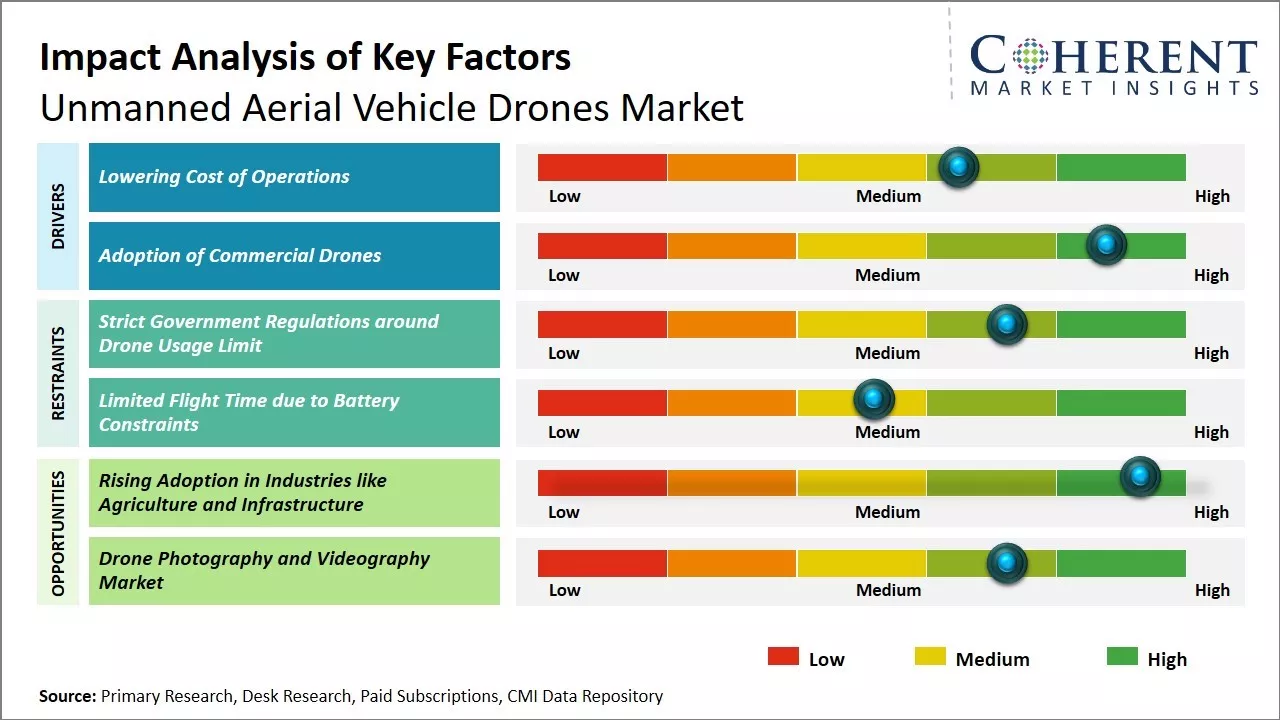
Discover market dynamics shaping the industry: Download Free Sample
The market is expected to witness significant growth during the forecast period. Rising adoption of drones across various industries for applications like infrastructure monitoring, agriculture monitoring, product delivery and photography is driving the market growth. Drones are also increasingly being used to monitor climate change and environmental impact. With reduction in regulatory restrictions, drones are finding critical applications in emergency response and monitoring. Furthermore, technological advancements in drones like increased battery life, autonomous flight and payload capacities are supporting increased commercial applications. However, concerns around drone privacy and security continue to pose challenges for full realization of growth opportunities. Increased investments in research and development of smart drones along with convergence of drones and 5G technologies can drive the market growth in the near future.
Lowering Cost of Operations
With UAV drones being able to carry out tasks that were traditionally done by manned aircraft or large equipment on the ground, it is significantly lowering the costs of operations for various industries. Drones can access hard to reach areas easily for inspection purposes with minimal support crew. This enables industries like oil & gas, construction, mining, and others to inspect remote infrastructure and gather data in a cheaper manner. Drone operations does not require setting up large manned teams at remote locations like offshore rigs or construction sites in difficult terrains. It results in reduced manpower costs and need for setting up temporary facilities at such locations. Similarly for agricultural sector, drones can monitor farms and carry out crop inspections much more easily than deploying humans. This allows farmers to keep a close check on their fields without having to spend on traveling to remote locations or hiring pilots. Even for filmmaking and media production houses, aerial drone filming is proving to be more cost effective than operating helicopters or planes, providing flexibility to capture shots that were not possible earlier within tight budgets.
For instance, in August 2020, DJI, a drone manufacturing company, entered into partnership with U.S.-based Shell Oil Company to test and deploy DJI drone technology at its Deer Park Manufacturing Complex to improve efficiency and worker safety during industrial inspections and emergency incident response.
Market Concentration and Competitive Landscape
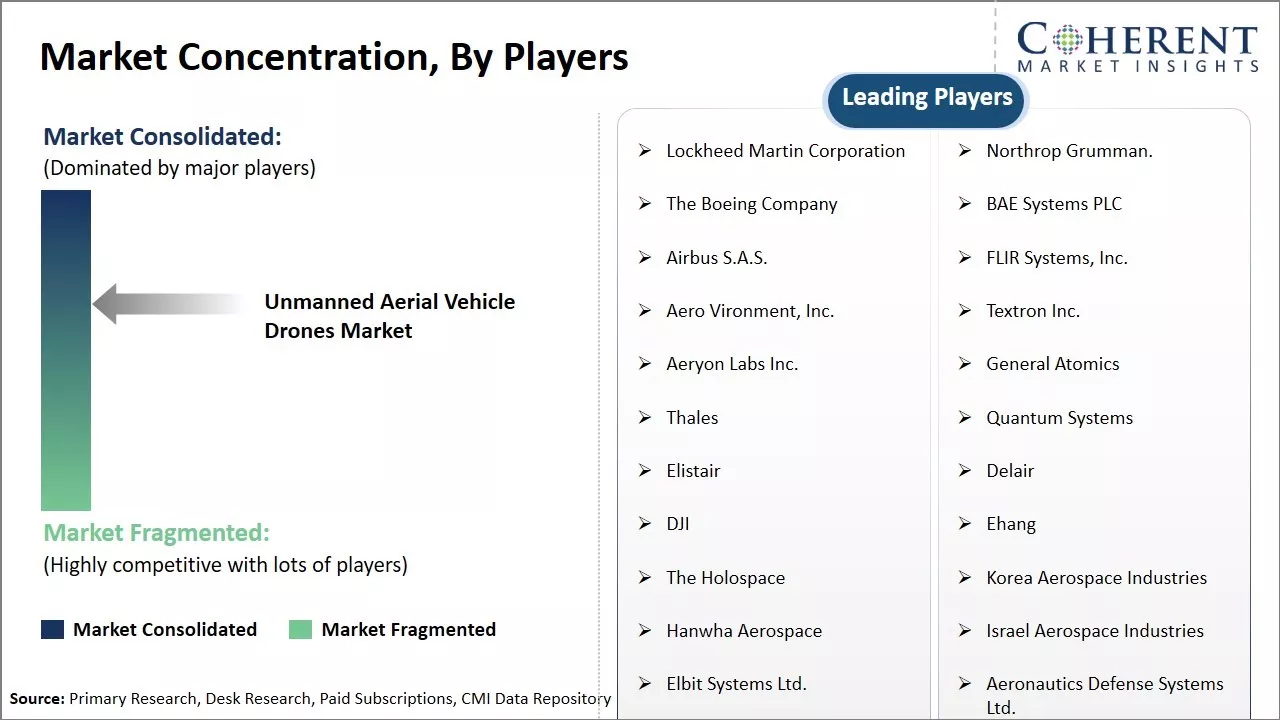
Get actionable strategies to beat competition: Download Free Sample
Adoption of Commercial DronesActive commercial drone programs implemented by many national aviation regulators around the world is opening up wide scope for deployment of drones across different industry verticals. Countries like U.S., Canada, China, India, and France have notified clear regulatory frameworks and guidelines for BVLOS (Beyond Visual Line of Sight) operations, night flights, flights over people for specific use cases. This provides legal certainty and lowers compliance risks for companies looking to integrate drones in their workflow. Several industries have been granted special approvals for experimental flights to prove drone capabilities. Successful trials are demonstrating the techno-commercial viability and leading to permanent permits. The commercial applications are also driving new vertical take-off and landing (VTOL) drone designs suited for specific tasks.
For instance, according to the Federal Aviation Administration (FAA), as of December 2023, 369,528 commercial drones were registered in the U.S.
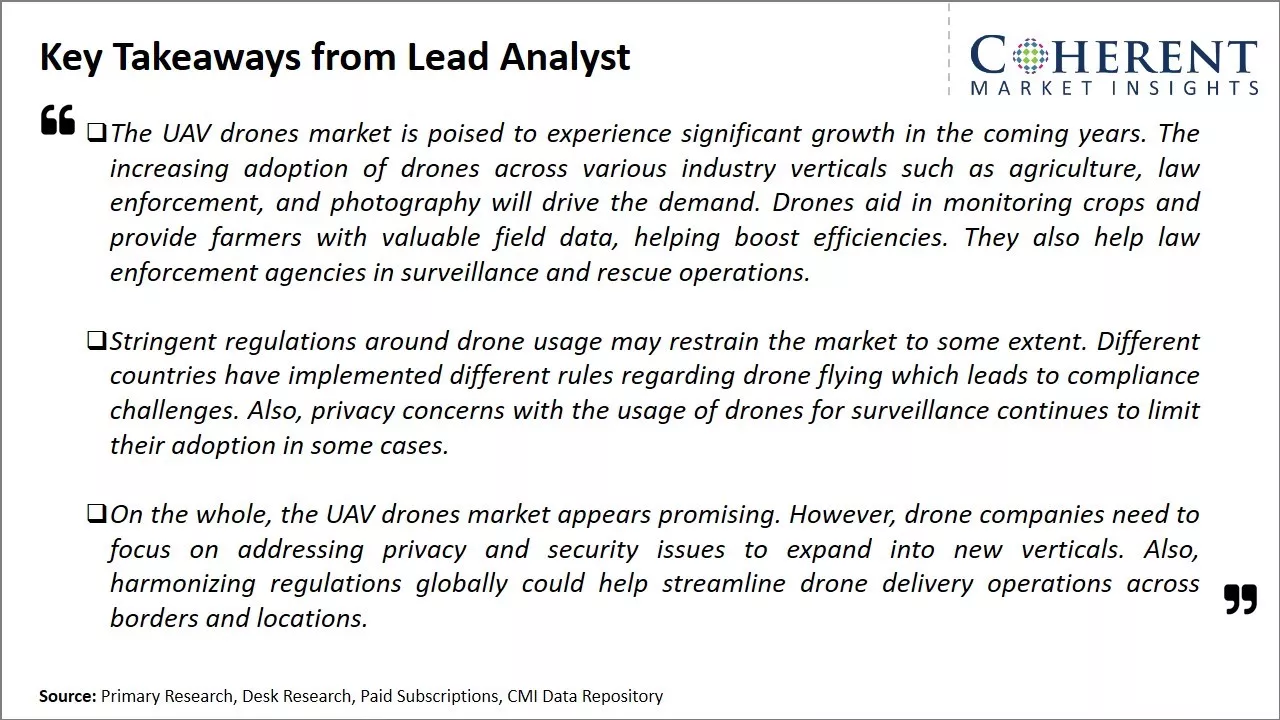
To learn more about this report, Download Free Sample
Market Challenges: Strict Government Regulations around Drone Usage LimitUnmanned aerial vehicle drones market faces several challenges. Strict government regulations around drone usage limit the scope of applications. Safety issues related to rogue drone flights or collision with aircrafts and buildings need to be addressed. High costs of sophisticated drones and limited battery capacities of smaller drones hamper widespread adoption. Lack of infrastructure for control and security of airspace used by drones is a challenge. Absence of air traffic management for drones can lead to chaos. Standardization issues around drone designs and payloads create interoperability challenges.
Market Opportunities: Rising Adoption in Industries like Agriculture and Infrastructure
The rising adoption of drones in agriculture and infrastructure industries could unlock tremendous opportunities in the unmanned aerial vehicle market. Drones are increasingly being used in precision agriculture for tasks like crop monitoring, soil and field analysis, and precision spraying of fertilizers and pesticides. This allows farmers to boost crop yields while using farm inputs more efficiently. Drones capture high-resolution images and data that help farmers identify problems in crops early. They can treat only areas that need attention, saving costs.
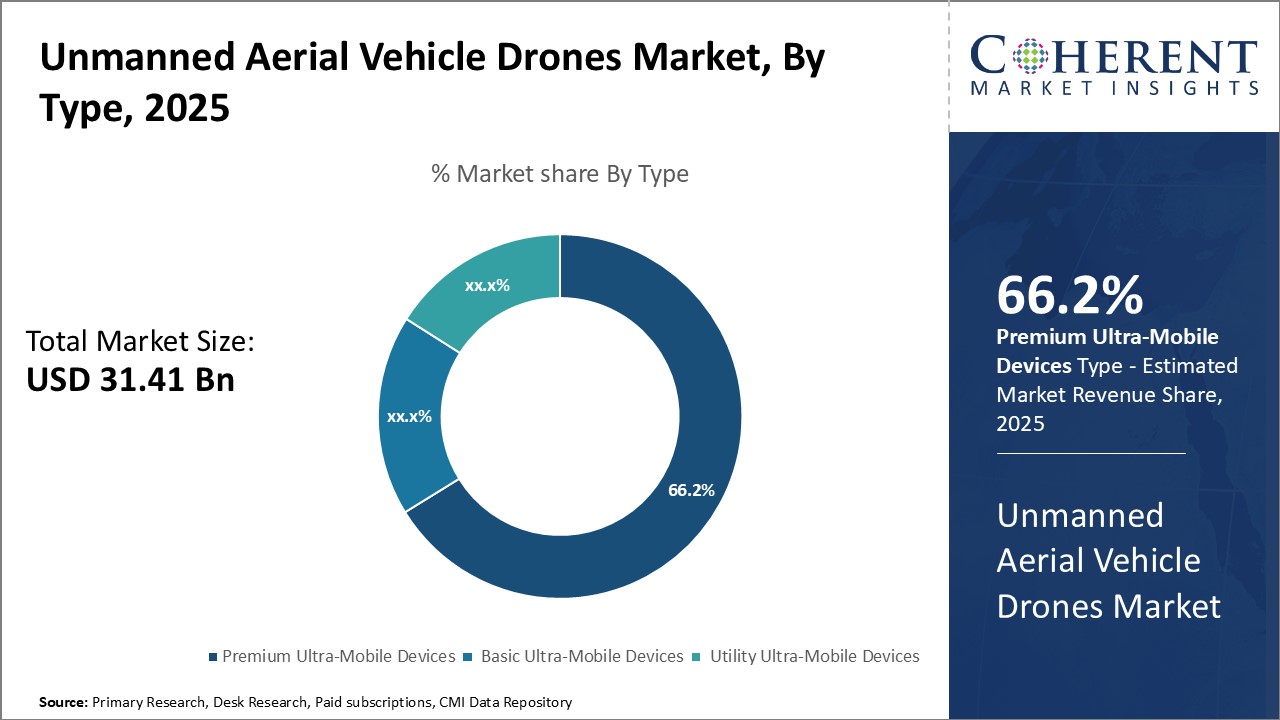
Discover high revenue pocket segments and roadmap to it: Download Free Sample
Insights, by type - Technological Advancements Drive Fixed Wing Drone DominanceFixed wing drone segment is estimated to contribute the highest share of 66.2% in the market in 2025 owing to rapid technological advancements. Fixed wing drones are designed to achieve longer flight times, greater payloads, and higher speeds compared to other drone types. Manufacturers have heavily invested in developing new fixed wing drone models with more advanced flight controls, navigation features, and payload capabilities. This has helped to increase their suitability for various commercial applications such as aerial mapping, surveillance, infrastructure inspection, and precision agriculture. The fixed wing design allows for smooth and efficient cruise flying over long distances without needing to flap wings or rotate propellers. New fixed wing drones also have advanced stabilization and autopilot functions for fully autonomous operations. Their energy efficient flying characteristics maximize flight duration, sometimes exceeding one hour on a single battery charge. These technological enhancements have significantly improved the operational efficiencies and productivity delivered by fixed wing drones. Their long flight ranges make fixed wing drones very useful for applications requiring surveillance of large areas or delivery of payloads over long distances. Overall, continuous technological innovations are enabling the design of more capable fixed wing drones, resulting in their highest market share among drone types.
For instance, Applied Aeronautics, a manufacturer of composite fixed-wing drones, offers Albatross Fixed Wing UAV, a fully autonomous electric fixed wing drone that features a modular design with interchangeable payload trays. It is completely customizable for all possible application areas such as surveillance, search and rescue, surveying & mapping.
Insights, by Load Capacity - More Than 5kg Load Capacity Segment dominates the market
More than 5KG segment is estimated to contribute the highest share of 72.2% in the market in 2025 due to its suitability for heavy payload applications. Drones with payloads exceeding 5KG find extensive uses in commercial sectors including infrastructure inspection, precision agriculture, and public safety operations. These have sturdier builds and powerful motors capable of lifting and maneuvering with heavy professional-grade cameras, LiDAR sensors, aerial spraying tanks, and other specialized payloads. The higher lifting capacity also allows these drones to accommodate dual or multiple payloads for simultaneous data collection. Drones rated for loads above 5KG are usually larger fixed wing or multirotor models equipped with features like redundant power systems and auto-leveling capabilities for stable lifting even in windy conditions. Due to their heavy lifting abilities, these are fit for tasks like inspecting large structures, mapping wide agricultural fields, monitoring vast wildfire perimeters, and supporting emergency rescue operations over large areas. Many industries now leverage the productivity gains of automating such demanding missions with high capacity drones. This drives consistent demand for drones supporting payloads in the More than 5KG category.
For instance, Drone Volt, an international manufacturer in the field of professional civilian drones and embedded artificial intelligence, offers HERCULES 20 heavy lift drone, which can lift any type of payload up to 15kg. The flight time of this drone is up to 40 minutes.
Insights, by application - Inspection & Monitoring Dominates The Market By Virtue Of Wide Ranging Uses
Inspection & Monitoring segment is estimated to contribute the highest share of 39% in 2025 owing to its ubiquitous usage across multiple industry verticals. Drones are increasingly used to automate routine inspection and monitoring tasks, bringing significant improvements in safety, speed, cost-efficiency and data quality. In infrastructure industries, these enable close-range visual inspections of hard-to-reach areas on assets like towers, bridges, power lines, and wind turbines. This helps detect defects early and predict maintenance needs. In construction, drones monitor progress, ensure quality standards, and collect aerial site data for project management. These are also helpful for safe inspections around hazardous sites. In mining and quarrying, drones monitor slopes, stockpiles and open pits for changes or safety issues. Similarly, in public safety, these assist with border surveillance, search & rescue operations by providing aerial views. Drones also enable continuous agricultural monitoring of crops, livestock and orchards for signs of disease, weather damage or pest infestation. Their camera and sensor payloads provide automated real-time surveillance and analysis. Given their versatile usage, inspection and monitoring applications have become the key growth driver for entire commercial drone industry.
For instance, according to Economic and Social Commission for Asia and the Pacific- 2019, in Singapore, the Land Transport Authority aims to deploy drones for maintenance inspection of urban mass rapid transit and to enhance underground tunnel inspections, in order to gradually replace manual efforts.
Regional Insights
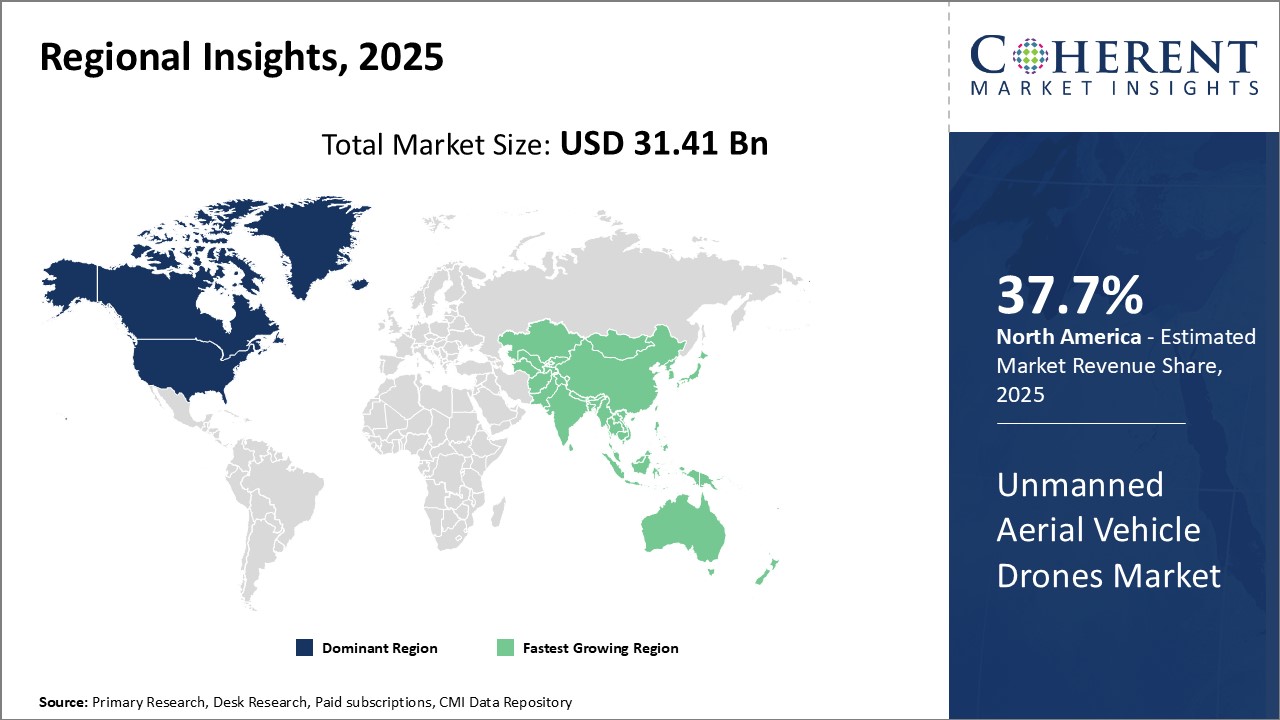
Need a Different Region or Segment? Download Free Sample
North America is estimated to hold the highest market share of 37.7% in 2025 in the global UAV drones market for years owing to strong presence of leading manufacturers and suppliers in the region. The U.S. accounts for the largest share and is home to major players like General Atomics, Lockheed Martin and Northrop Grumman who have been actively investing in research and development of advanced military drones. The government spending on procurement of reconnaissance and combat drones for defense has remained high. Several U.S.-based startups are also engaged in development of commercial drones and their applications in industries like agriculture, energy, infrastructure inspection. The pricing of drones in North America is on the higher side compared to global markets due to advanced features and technologies. However, exports have been increasing with growing global demand from both defense and civilian applications.
Asia Pacific region has emerged as the fastest growing market for UAV drones and is expected to witness exponential rise in demand going forward. China dominates the Asia Pacific market with notable production of military and commercial drones. Countries like India, Japan and South Korea are also contributing significantly with their own indigenous programs as well as imports from other nations. As the application areas are diversifying into sectors like precision agriculture, surveillance and delivery services, the demand from Asian countries is surging at a rapid pace. The import of agricultural and delivery drones has risen while defense imports remain restricted. On the pricing front, drones manufactured in Asia offer competitive rates making the region an attractive outsourcing hub as well. With strong industrial base, availability of raw materials and focus on new technologies, Asia Pacific is well positioned to lead the future growth of global UAV drones industry.
Market Report Scope
Unmanned Aerial Vehicle Drones Market Report Coverage
| Report Coverage | Details | ||
|---|---|---|---|
| Base Year: | 2024 | Market Size in 2025: | USD 31.41 Bn |
| Historical Data for: | 2020 To 2024 | Forecast Period: | 2025 To 2032 |
| Forecast Period 2025 to 2032 CAGR: | 10.6% | 2032 Value Projection: | USD 63.63 Bn |
| Geographies covered: |
|
||
| Segments covered: |
|
||
| Companies covered: |
Lockheed Martin Corporation, Northrop Grumman., The Boeing Company, BAE Systems PLC, Airbus S.A.S. , FLIR Systems, Inc., Aero Vironment, Inc., Textron Inc., Aeryon Labs Inc., General Atomics, Thales, Quantum Systems, Elistair, Delair, DJI, Ehang, The Holospace, Korea Aerospace Industries, Hanwha Aerospace, Israel Aerospace Industries, Elbit Systems Ltd., Aeronautics Defense Systems Ltd. |
||
| Growth Drivers: |
|
||
| Restraints & Challenges: |
|
||
Uncover macros and micros vetted on 75+ parameters: Get instant access to report
Unmanned Aerial Vehicle Drones Industry News
- In January 2021, AeroVironment, Inc., a U.S.-based provider of unmanned aircraft systems and tactical missile systems, acquired Arcturus UAV, a privately-held manufacturer of Group 2 and 3 unmanned aircraft systems (UAS) and services company for a total purchase price of US$ 405 million. Furthermore, this acquisition contributed in strengthening the position of AeroVironment in the North America market.
- In April 2020, Orbital Corporation, an Australia based company, signed a deal with Northrop Grumman Corporation, a manufacturer of unmanned aerial vehicles, to develop a hybrid propulsion system for a vertical take-off and landing (VTOL) unmanned aerial vehicle (UAV)
- In December 2020, AeroVironment, Inc., a U.S.-based provider of unmanned aircraft systems and tactical missile systems, acquired Telerob Gesellschaft für Fernhantierungstechnik GmbH, a Germany-based ground robotic solutions company, for around US$ 45.4 million in cash, and will pay-off around US$ 9.4 million in Telerob’s debt at closing. Furthermore, this acquisition contributes in strengthening the presence of the company in the Germany, thereby increasing market share of the company in the Europe region.
- In April 2020, AeroVironment, Inc., a U.S.-based provider of unmanned aircraft systems and tactical missile systems, introduced Quantix Recon fully-automated hybrid vertical take-off and landing (VTOL) unmanned aircraft system (UAS) for defense applications
- In January 2020, Israel Aerospace Industries (IAI), aerial and astronautic systems manufacturer, introduced Heron Mk II Medium Altitude Long Endurance (MALE) Unmanned Aerial Vehicle (UAV) at the Singapore Airshow
*Definition: Unmanned aerial vehicle drones market consists of small, unmanned aircraft or drones that can be remotely controlled or fly autonomously using software-controlled flight plans. UAV drones are used commercially for purposes such as aerial photography, agriculture, infrastructure inspection, emergency management, and product delivery. Thse allow organizations to capture images, video footage, and other data quickly and cost-effectively without endangering human pilots.
Market Segmentation
- Type Insights (Revenue, USD Bn, 2020 - 2032)
- Premium Ultra-Mobile Devices
- Basic Ultra-Mobile Devices
- Utility Ultra-Mobile Devices
- End User Insights (Revenue, USD Bn, 2020 - 2032)
- Enterprises and Businesses
- Educational Institutions
- Government and Public Sector
- Individual Consumers
- Regional Insights (Revenue, USD Bn, 2020 - 2032)
- North America
- U.S.
- Canada
- Latin America
- Brazil
- Argentina
- Mexico
- Rest of Latin America
- Europe
- Germany
- U.K.
- Spain
- France
- Italy
- Russia
- Rest of Europe
- Asia Pacific
- China
- India
- Japan
- Australia
- South Korea
- ASEAN
- Rest of Asia Pacific
- Middle East & Africa
- GCC Countries
- Israel
- Rest of Middle East & Africa
- North America
- Key Players Insights
- Lockheed Martin Corporation
- Northrop Grumman.
- The Boeing Company
- BAE Systems PLC
- Airbus S.A.S.
- FLIR Systems, Inc.
- Aero Vironment, Inc.
- Textron Inc.
- Aeryon Labs Inc.
- General Atomics
- Thales
- Quantum Systems
- Elistair
- Delair
- DJI
- Ehang
- The Holospace
- Korea Aerospace Industries
- Hanwha Aerospace
- Israel Aerospace Industries
- Elbit Systems Ltd.
- Aeronautics Defense Systems Ltd.
Share
Share
About Author
Suraj Bhanudas Jagtap is a seasoned Senior Management Consultant with over 7 years of experience. He has served Fortune 500 companies and startups, helping clients with cross broader expansion and market entry access strategies. He has played significant role in offering strategic viewpoints and actionable insights for various client’s projects including demand analysis, and competitive analysis, identifying right channel partner among others.
Missing comfort of reading report in your local language? Find your preferred language :
Transform your Strategy with Exclusive Trending Reports :
Frequently Asked Questions
EXISTING CLIENTELE
Joining thousands of companies around the world committed to making the Excellent Business Solutions.
View All Our Clients
